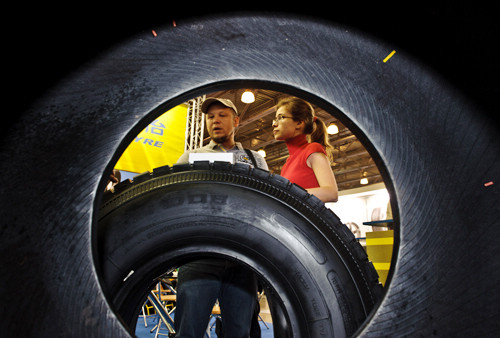|
 |
|
LOOKING ELSEWHERE: Visitors to the International Auto and Accessories Fair, held in Moscow in August 2011, look at China's Triangle tires (JIANG KEHONG) |
As a result of the tariff, U.S. consumers suffered tire price increases. Around the time when Chinese tires were shut out of the U.S. market, the price of tires in the United States jumped over 10 percent.
Ma described the U.S. tariff as a decision "that harms others but brings no profit to itself either."
In the wake of the WTO ruling, the Chinese Preferment Mission to the WTO said the U.S. decision is a protectionist measure imposed only to accommodate the country's domestic political pressure."
The U.S. Government needs to find a scapegoat for its sluggish economic recession and job loss, and China's swift economic rise has given the U.S. a good reason to punish, said Wei Liang, an assistant research fellow with the Institute of World Economic Studies at the China Institutes of Contemporary International Relations.
"The WTO ruling over the tire case was against the basic WTO principle, namely, the non-discriminatory. China is not the only tire exporter for the United States, but the United States only targeted China. It is an utter discrimination against China," Zhou Shijian, a senior research fellow with the Center for U.S.-China Relations at Tsinghua University.
"Using China as its scapegoat for an ailing economy and job losses, it will take a toll on the Chinese economy. As a matter of fact, the biggest loser will be the United States itself," Ma said. "If not taken seriously, finally, the Sino-U.S. trade friction will be a disaster to the world economy."
The United States has set a negative example for others. India, Argentina, Brazil and other countries have launched or intend to launch safeguards and anti-dumping investigations on Chinese-manufactured tires.
China's loss in the WTO ruling is a big one. Because WTO rulings are adopted by all members, other countries are sure to follow suit in placing the blame for lost jobs or poor industrial growth on China, said Larry Lang, an economics professor at the Chinese University of Hong Kong.
Actually, government subsidies exist widely in many industries in the United States with the automobile, aircraft and photovoltaic industries being the biggest beneficiaries of national subsidies, said Zhong Shi, an independent analyst of automobile industry.
"It is unfair. China should launch anti-subsidy investigations on U.S. exports," he said.
In September 2010, China began levying anti-dumping duties from 50.3 percent to 105.4 percent on imports of U.S. chicken products for five years.
The decision was based upon findings of an investigation by China's Ministry of Commerce, which shows that the U.S. chicken industry has dumped broiler products into the Chinese market and caused "substantial damage" to China's domestic industry.
Chicken from the United States is cheap, because the U.S. Government has been providing high subsidies for its corn planters, said Lang. From 1998 to 2008, Loan Deficiency Payment for the U.S. farmers cost its tax payers $29 billion. According to a Canadian report, for every dollar U.S. farmers earn, 62 cents comes from some form of government subsidy, with total aid from all levels of government adding up to more than $180 billion in 2009.
Among the subsidies, feed grains account for the biggest share of around 35 percent, cited Xinhua News Agency.
The United States announced on September 21, 2011 that it was taking action through the WTO by challenging Chinese duties on U.S. poultry products.
The move is illogical, said Xinhua. The United States does not check its policies on agricultural products. Instead, it took action against China, where a number of poultry industries have fallen victim. | 